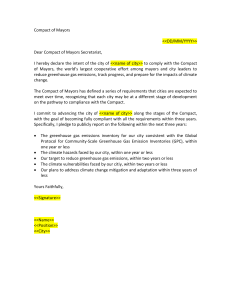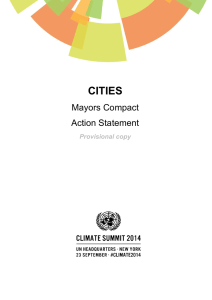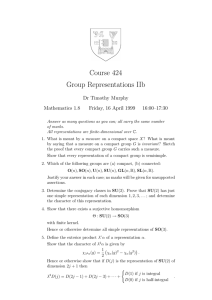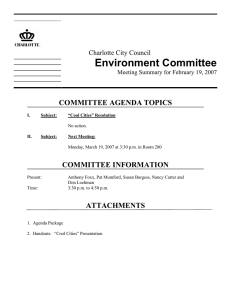Document 12947247
advertisement
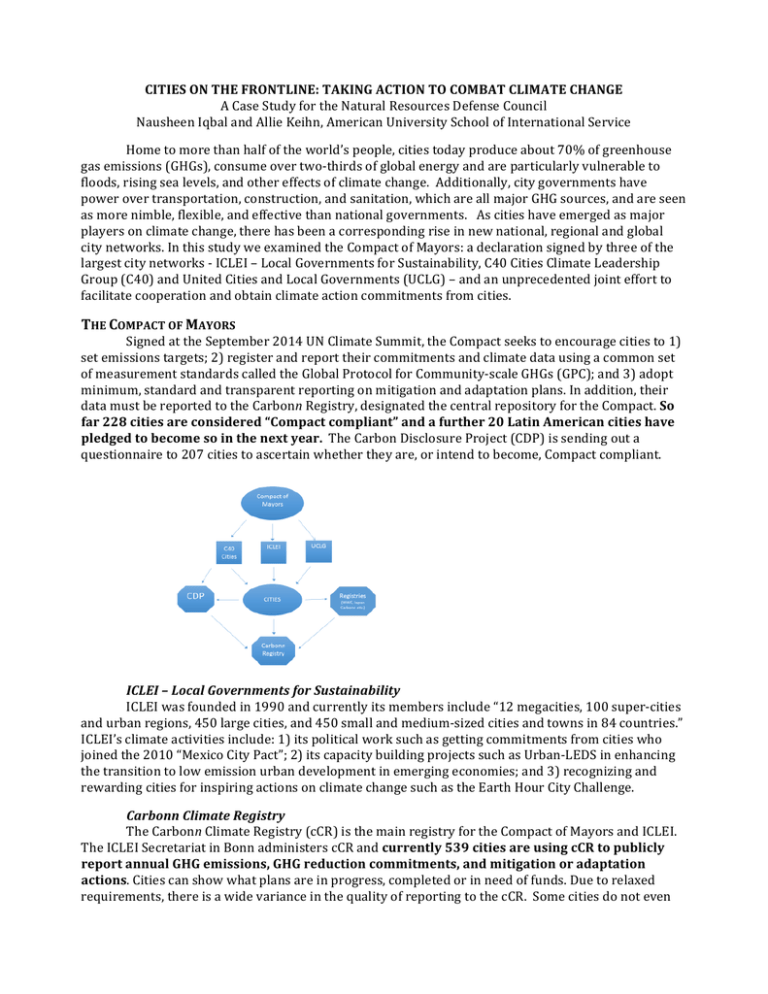
CITIES ON THE FRONTLINE: TAKING ACTION TO COMBAT CLIMATE CHANGE A Case Study for the Natural Resources Defense Council Nausheen Iqbal and Allie Keihn, American University School of International Service Home to more than half of the world’s people, cities today produce about 70% of greenhouse gas emissions (GHGs), consume over two-­‐thirds of global energy and are particularly vulnerable to floods, rising sea levels, and other effects of climate change. Additionally, city governments have power over transportation, construction, and sanitation, which are all major GHG sources, and are seen as more nimble, flexible, and effective than national governments. As cities have emerged as major players on climate change, there has been a corresponding rise in new national, regional and global city networks. In this study we examined the Compact of Mayors: a declaration signed by three of the largest city networks -­‐ ICLEI – Local Governments for Sustainability, C40 Cities Climate Leadership Group (C40) and United Cities and Local Governments (UCLG) – and an unprecedented joint effort to facilitate cooperation and obtain climate action commitments from cities. THE COMPACT OF MAYORS Signed at the September 2014 UN Climate Summit, the Compact seeks to encourage cities to 1) set emissions targets; 2) register and report their commitments and climate data using a common set of measurement standards called the Global Protocol for Community-­‐scale GHGs (GPC); and 3) adopt minimum, standard and transparent reporting on mitigation and adaptation plans. In addition, their data must be reported to the Carbonn Registry, designated the central repository for the Compact. So far 228 cities are considered “Compact compliant” and a further 20 Latin American cities have pledged to become so in the next year. The Carbon Disclosure Project (CDP) is sending out a questionnaire to 207 cities to ascertain whether they are, or intend to become, Compact compliant. ICLEI – Local Governments for Sustainability ICLEI was founded in 1990 and currently its members include “12 megacities, 100 super-­‐cities and urban regions, 450 large cities, and 450 small and medium-­‐sized cities and towns in 84 countries.” ICLEI’s climate activities include: 1) its political work such as getting commitments from cities who joined the 2010 “Mexico City Pact”; 2) its capacity building projects such as Urban-­‐LEDS in enhancing the transition to low emission urban development in emerging economies; and 3) recognizing and rewarding cities for inspiring actions on climate change such as the Earth Hour City Challenge. Carbonn Climate Registry The Carbonn Climate Registry (cCR) is the main registry for the Compact of Mayors and ICLEI. The ICLEI Secretariat in Bonn administers cCR and currently 539 cities are using cCR to publicly report annual GHG emissions, GHG reduction commitments, and mitigation or adaptation actions. Cities can show what plans are in progress, completed or in need of funds. Due to relaxed requirements, there is a wide variance in the quality of reporting to the cCR. Some cities do not even provide information on their targets or actions, only their current emissions inventories. Others such as Vancouver are rather expansive, with information on 116 actions the city is undertaking to address climate change. Cities are also not required to report annually and many do not update their reports on a regular basis. C40 Cities Climate Leadership Group Founded in 2005, C40 is a global network of 75 cities dedicated to reducing GHGs and creating sustainable infrastructure in seven initiative areas, which include transportation, adaptation and water, and energy. Membership is by invitation only to cities and mayors that have an excellent track record of passing and enforcing climate friendly policies and confers prestige on its members. C40 supports cities by offering technical expertise and measuring tools for GHG emissions as well as connecting cities on topics of common interest such as solid waste management. Thus, cities looking to implement a bus rapid transit system or accelerating the uptake of district heating and cooling systems can actively exchange information on challenges, best practices and implementation advice. CONCLUSIONS & RECOMMENDATIONS Harmonize and Consolidate Measurement and Reporting Cities around the world are at different stages in becoming climate smart and benefit from access to a diverse range of networks that meet their specific needs. Thus, diversity of city networks can be of real value. However, the proliferation in city networks has created substantial burdens for cities as they are asked to annually report the same data, but use different protocols, resulting in public datasets that are incomparable. Also, networks end up competing with each other for funding and memberships of “prestigious” cities. Our recommendation is that the harmonization and consolidation called for by the Compact, which includes using the GPC for measuring GHG emissions and using Carbonn as the central reporting registry, should be operationalized as soon as possible with technical trainings for city staff and implementation of software that streamlines the reporting process. Improve Transparency Each network and platform needs to be much more transparent, especially in regards to making contact information for themselves and their members easily accessible on their website. We were unable to find any contact information on commitment makers in order to follow up on their climate action plans and our inquiries to the general email addresses were never returned. Encourage Greater Accountability for Commitments Since cities are becoming more recognized as critical actors in addressing climate change, there should be much greater attention towards ensuring that they are implementing their promises to take action. We found that the city networks were reluctant to create formal accountability mechanisms for their members. It might be more productive at this time to focus instead on awards and financial incentives to encourage cities to fulfill their pledges. An interesting model is the WWF Earth Hour City Challenge, where cities upload their data to Carbonn and a third-­‐party firm verifies it before one city is awarded the Earth Hour Capital Award and gets local and international recognition for inspiring climate actions as well as formal verification of its data. Close the Finance Gap Getting finance for climate actions down to the local level is a major concern. Our recommendation is that city networks advise international development banks, philanthropies, and other major donors to use the standards set by the Compact as a basis for funding climate actions in cities that become Compact compliant. We would encourage city networks to marshal the resources of the new Cities Climate Finance Leadership Alliance in order to close the investment gap and channel funding directly to cities. For the complete report on cities please contact Nausheen Iqbal (ni9147a@american.edu) or Allie Keihn (akeihn@yahoo.com)
